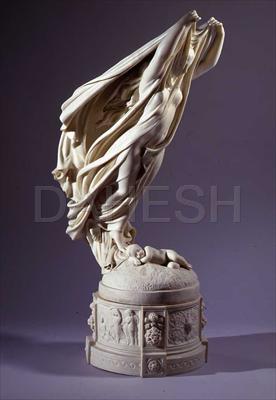
The Dahesh Museum of Art opened to the public in 1995 on Fifth Avenue with a unique mission—to provide the public with a fresh look at European academic art of the 19th and early 20th centuries, and to assess the impact of the academic tradition—training, style, subject matter, and ideals—on the world of art. Cultural authorities had long relegated this tradition to the margins of art history, so only a few American museums exhibited academic works or explored the achievements of these artists and their legacies.
For over 25 years since that 1995 opening, the Museum has led an astonishing revival of interest in academic art. In addition to the Museum’s publications, individual scholars and institutions have produced many important monographs and studies of the period, and collectors have discovered a rewarding field that still offers significant works on the market.
During its eight years on Fifth Avenue, the Museum organized and presented 23 exhibitions (each with its own publication) within a modest 1,800 square feet of space. Colleagues and visitors alike praised its ambitious vision and programming, and the dialogue it helped foster has inspired new scholarship and interest in such areas as Orientalism, academic training, the continuity of religious art, and fresh approaches to genre subjects. The Museum developed many collaborative projects with institutions throughout the United States and abroad.
In September 2003, the Museum re-opened at 580 Madison Avenue with the exhibition, French Artists in Rome: Ingres to Degas, 1803–1873, which was named one of the 10 best exhibitions of the year by Michael Kimmelman, New York Times chief art critic. This more expansive space included galleries for the growing permanent collection, as well as innovative exhibitions in the academic training process and influence of academic art in areas as varied as opera and the history of American illustration. The diverse audience for these exhibitions and publications included contemporary artists, tourists, scholars of 19th-century and turn-of-the-century culture, the city’s discerning museum-going public, and younger people discovering an almost-forgotten art.
As it has matured, the Museum has proven itself both an innovative presenter and effective partner with large, prestigious museums such as the École des Beaux-Arts, Musée d’Orsay and Musée du Louvre, Paris; Van Gogh Museum, Amsterdam; The Hermitage, St. Petersburg; Kunstmuseum Dusseldorf; Musée des Beaux-Arts, Brussels; and Kunsthalle, Munich. The list of distinguished smaller institutions includes the Santa Barbara Museum of Art, California; Princeton University Art Museum; La Scala Opera House, Milan; Musée Goupil, Bordeaux; the French Academy in Rome; and the Syracuse University Art Galleries. The list of Museum publications has also grown. Many have become standard publications of their subjects, and the catalogue for the Charles Bargue exhibition is truly a “best-seller,” continuing to attract scholars and art students.
In September 2007, the Dahesh Museum of Art closed its doors at 580 Madison and has become for now a museum without walls, traveling exhibitions from the collection and sharing works in major exhibitions. Napoleon on the Nile (very positively reviewed in The New Yorker) traveled to several museums on both East and West coasts. Pepperdine University’s Frederick R. Weisman Art Museum in Malibu, CA, was the venue in winter 2012 for The Epic and the Exotic, an exhibition of DMA masterworks. In addition to 2012 exhibitions at the Munson-Williams-Proctor Art Institute, Utica, NY, and the Bellarmine Art Museum, Fairfield University, CT, the Museum continues to lend important works from its rich and now-renowned collection to museums in America and abroad. A select group of masterpieces will be the centerpiece of the Yale Peabody Museum’s important Echos of Egypt: Conjuring the Land of the Pharaohs exhibition in 2013.
In July 2012 the Museum acquired a new space in the lively and upcoming Hudson Square neighborhood in lower Manhattan. This new facility includes an office and library for staff use and an elegant public space, an expanded Museum Store and public programming area for lectures.
The Museum’s Collection
The Dahesh Museum of Art’s permanent collection originated with Dr. Dahesh (1909–1984), the pen name of Salim Moussa Achi, an influential Lebanese writer, philosopher, and connoisseur, in whose honor the Museum is named. Envisioning a premier art museum, he collected paintings, sculptures, drawings, prints, photographs, and books by academically trained artists of the 19th and 20th centuries. Friends brought Dr. Dahesh’s collection from Beirut to America in 1976 and chartered the museum in 1987. The Board of Trustees secured the Fifth Avenue location and hired a professional staff, which researched and oversaw conservation of the collection, then planned a program of exhibitions and publications, all before opening to the public in 1995.
A vital museum constantly aspires to improve its collection, and purchases and generous donations have enhanced the ability of the Museum to demonstrate the diversity and richness of the academic tradition. Since the Museum published Highlights, a handy guide book to the collection in 1999, it has acquired many works and is preparing a new handbook that will document both old favorites and new works. The academic tradition was strongest in France, so the collection is richest in works from that country, but the Museum has been actively acquiring examples of British, German, and other European work. Many Americans studied abroad in academies and private ateliers, providing a new direction in collecting academic art. The Dahesh Museum of Art is constantly seeking new ways to accomplish its mission.
The Dahesh Museum of Art is a 501(c)3, not-for-profit organization chartered by the State of New York.


